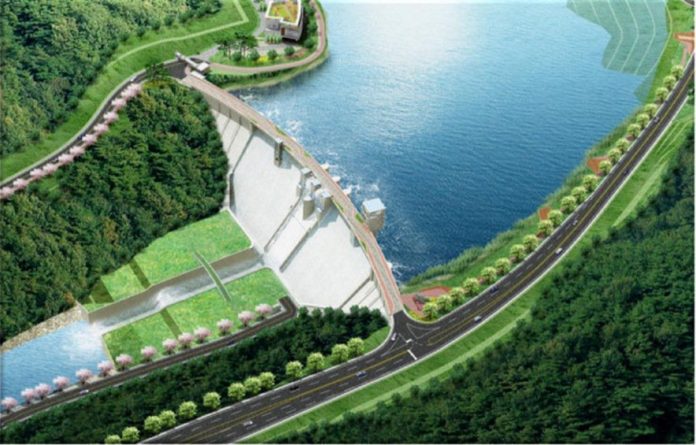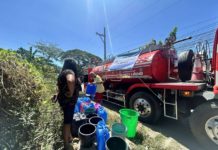
ILOILO – Construction of the P11.2-billion Jalaur River Multipurpose Project Phase II (JRMP II) in Calinog town could stretch for three years. It may also possibly need one million cubic meters of quarry materials, according to the Provincial Environment and Natural Resources Office (PENRO). Does the province have enough sand and gravel for the gargantuan project?
If PENRO chief Atty. Arturo Cangrejo were to be believed, there is enough sand and gravel for the mega dam that when completed would be the biggest dam outside Luzon.
Only last year, Cangrejo warned that the province may be running out of sand and gravel needed for government infrastructure projects and private undertakings. Some contractors of road projects applied for sand and gravel quarry permits as far as Antique and even Leyte, he revealed.
The Jalaur mega dam involves the building of a 109-meter Jalaur High Dam, 38.5-meter Afterbay Dam, 10-meter Alibutan Catch Dam, 80.74-kilometer Highline Canal, and its appurtenant structures. Construction started on the last quarter of 2018.
To ensure there would be no shortage of quarry materials, the PENRO may approve more quarry permit applications, said Cangrejo.
Last year, there were two Calinog-based quarry operators, PENRO records showed.
“With all nga nagasulod nga applications I think indi ma-short sa kinanglanon nga quarry materials,” said Cangrejo.
If quarry materials from Calinog are not enough, other sources may be tapped such as the towns of Dueñas and Lambunao, he said.
Among the contractors that expressed concern to PENRO last year were those that bagged government contracts for the Philippine Rural Development Program of the Department of Agriculture – a World Bank-funded program supporting the development of rural infrastructure such as roads, bridges, communal irrigation systems, potable water supply, solar dryers, greenhouses, and composting facilities, among others, to boost rural incomes and reduce poverty.
“The demand for sand and gravel is high due to a lot of government infrastructure projects in Iloilo. Add to that private construction activities,” said Cangrejo.
The Jalaur mega dam, once operational, will provide uninterrupted irrigation water supply to 32,000 hectares of farmland, benefit more than 24,000 farmers and increase annual production of rice to 300,000 metric tons from 140,000 in Iloilo.
The project will also generate approximately 17,000 local jobs equivalent to P1.3 billion in basic wages per year.
JRMP was first implemented by NIA in the 1960s after the fourth Congress passed Republic Act 2651, which provided for the construction of the JRMP in Iloilo. Its first phase was completed in 1980s but its second phase was derailed for over five decades due to lack of funds.
Mountains may be good alternatives to rivers for quarrying sand and gravel, according to Gov. Arthur Defensor Sr. last year.
The Department of Public Works and Highways (DPWH) observed the slow implementation of its projects and learned from contractors that “insufficiency of aggregates” such as sand and gravel contributed to the delay. Region Director Wenceslao Leaño Jr. then warned of further delays if the dwindling supply of sand and gravel was not addressed.
During a 2016 “quarry summit” organized by the provincial government, the Mines and Geosciences Bureau (MGB) said there were mountains in northern Iloilo where filling materials could be sourced. MGB gave PENRO a map. It was not clear, however, if PENRO was able to make follow-ups.
MGB warned that in three years, there may not be enough sand and gravel in Iloilo to meet the demands of the local construction industry./PN




The solution is crusher. Look for possible source of rocks to be to crusher there are a lot of places in WV specially in Iloilo province that could be a better source of rock that could feed the crusher for possible supply of sand and gravel from 2″ gravel to fine sand with a good quality.
The above comment is ‘right on the money’. Guam which has no riverbed source(s) of sand and gravel, uses manufactured aggregates from coral/coralline for its extensive concrete aggregates requirements. Automated crushers and sieving systems are used extensively.
The above comment is “right on the money.” If sufficient riverbed sand and gravel in sufficient quantity in Iloilo won’t be available, fine and course aggregates for concrete aggregates can be manufactured (crushed) from the bigger-sized riverbed rocks/stones/boulders. Also, hard coral/limestone (coralline) can be processed into concrete-sized aggregates. Guam which practically has no riverbed-type stones/sand, uses processed (crushed/milled) hard coral/limestone for its extensive concreting requirements.
Iloilo province may be running out of sand and gravel for this project but there are rivers in Capiz, Aklan & Antique too besides the hills and mountain all over Panay Islands. These lacks of aggregates are not valid reasons for excuses. There is no WILL in the side of the Philippine government to make this project happens!
There is no such things as shortage of gravel and sand in Panay Island, but I am certain that there is no will in the Government to pursue and build this river Dam infrastructure. We are back again to where we are 50 years ago that is simply “The People who will build this magnificient PROJECT are not born yet nor they exist in his WORLD and time. This is the death of the most biggest to be seen and an ever existing of the “Monay Smile” every one are eager to see in this unforgettable History ever!